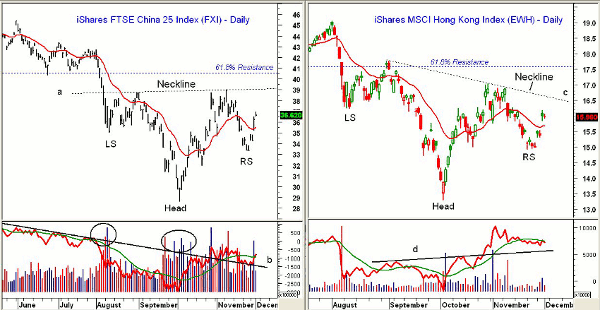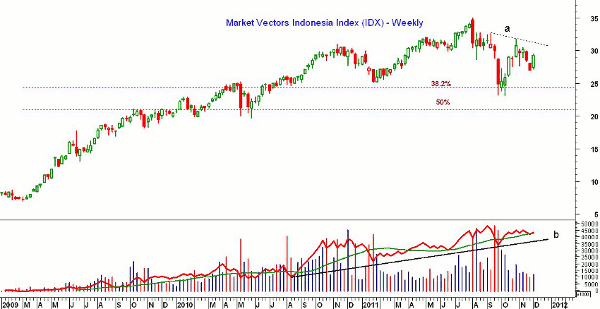These Asian ETFs all show similar bottoming formations on the charts, and renewed economic growth in China could spur these funds to big gains in 2012.
The decision this week by the Peoples Bank of China to lower bank reserves caught the market by surprise and boosted the Hang Seng Index by over 1000 points. This was the first lowering of reserves since 2008 and suggests that Chinese leaders are concerned that the economy is slowing down too fast.
The initial enthusiasm over the news was dampened a bit on Friday by unconfirmed reports that bank loans fell in November. Accounting irregularities at several companies and unconfirmed charges of fraud against Sino-Forest (TRE) and Focus Media Holdings (FMCN) have made even some hedge funds avoid Chinese stocks.
Of course, this level of bearish sentiment is what we would like to see at a market bottom. In February 2009, a survey of investors indicated that less than 5% were planning on investing in the emerging markets. As it turned out, many of the emerging market ETFs like the iShares MSCI Emerging Market Index Fund (EEM) made their lows in late 2008.
Both the iShares FTSE China 25 Index Fund (FXI) and the iShares MSCI Hong Kong Index Fund (EWH) show similar bottoming formation that have not yet been confirmed, while another Asian ETF appears to have completed its correction.
Chart Analysis: The iShares FTSE China 25 Index Fund (FXI) dropped to a low of $28.61 on October 4, which is well below the 2010 high of $47.99. The daily chart appears to show a reverse head-and-shoulders (H&S) bottom formation.
- The August low saw the heaviest volume and is labeled as the left shoulder (LS), while the October low is likely the head
- The right shoulder (RS) may have been completed last week with the low at $33.33. Volume was even lower as the LS was being formed
- The close above the neckline (line a) at $39 would complete the reverse H&S bottom and give upside targets in the $48 area
- The major 61.8% Fibonacci retracement resistance is at $40.50
- Daily on-balance volume (OBV) broke its downtrend, line b, in late October and has just retested the breakout level
- Weekly OBV (not shown) is still below its weighted moving average (WMA)
- Minor support stands at $35.50 and the 20-day exponential moving average (EMA)
The daily chart of the iShares MSCI Hong Kong Index Fund (EWH) shows a similar, but less symmetrical reverse H&S formation.
- The August low (LS) at $16.42 had the heaviest volume, as almost 49 million shares were traded
- The October low (Head) at $13.30 was over 34% below the November 2010 high at $20.24. Volume in October was just 15 million shares
- The right shoulder (RS) from a week ago corresponded to a low of $14.92 and had light volume of 5.5 million shares
- Daily OBV broke through resistance, line d, in late October. It held above this support as the right shoulder (RS) was being formed
- Weekly OBV is still negative and below its weighted moving average
- A close above the downward-sloping neckline (line c) would project a move to the $20-$21 area
- Minor support stands at $15.70 and the 20-day EMA
NEXT: Another Asian ETF Putting in a Bottom; How to Profit
|pagebreak|The Market Vectors Indonesia Index (IDX) peaked at $34.99 in early August and then corrected with the rest of the global markets. The major 38.2% retracement support at $24.24 was violated in September and October, but not on a weekly closing basis. This correction was relatively small when compared to the declines in other emerging and developed markets.
- The major 50% retracement support stands at $21.04
- Weekly OBV confirmed the August highs and is now back above its still-rising weighted moving average. This is a bullish sign
- Daily OBV (not shown) is acting weaker than its weekly counterpart and is just neutral
- On the weekly chart, IDX could have completed an A-B-C correction, and a move above resistance at line a in the $31.25 area would confirm this interpretation
- There is additional resistance at $32.76
What It Means: If the Chinese government has started on a path to reinflate the economy, it should be very positive for the Asian markets, which could turn out to be the star performers in 2012.
I would wait until the reverse H&S bottoms are completed before buying either FXI or EWH, but IDX looks attractive now on a slight pullback.
How to Profit: For the iShares FTSE China 25 Index Fund (FXI), on a close above $38.90, buy at $38.34 or better with a stop at $33.82.
For the iShares MSCI Hong Kong Index Fund (EWH), on a close above $17.15, buy at $16.84 or better with a stop at $14.90.
For the Market Vectors Indonesia Index (IDX), go 50% long at $28.88 and 50% long at $28.42 with a stop at $26.78.












